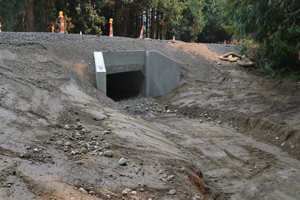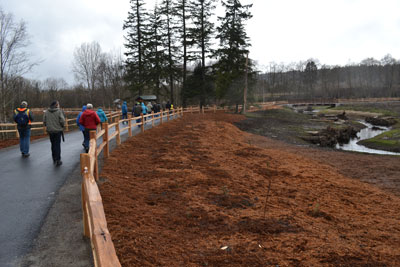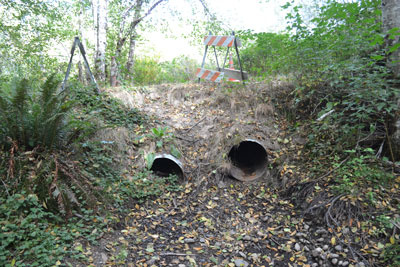Summer Stream Flows and Fish Passage
The estimated cost of the bridge is around $80,000. We are off to a good start and have collected about $35,000. Preliminary engineering site work was donated by WNEK Engineering, and AES Consultants. Stewards and engineers are gathering flow volumes, rating the wetlands and getting all the permit data requirements completed.
In order to improve fish passage across Old Loop Parkway ,we need to design and install a bridge that will allow all life phases of fish to move upstream to rearing habitat. Opening this passage, will allow Coho and Sea-run Cutthroat to access about 50 acres of prime habitat, and restore natural stream processes. We had our first successful Coho hatch in 2016, only to loose all the fry when they became trapped and predated when water levels dropped. A bridge would prevent this from happening in the future by allowing the fry to reach the safety of the large wetland above the beaver dam.
Why do we need a bridge?
A bridge IS the best option for optimal fish passage and natural stream processes to occur. A bridge allows the channel to meander, and delivers sediment and nutrients downstream while maintaining a stream channel. If we raise enough money we will install a bridge. Cost is important, and we don't want to spend more than necessary. Washington Department of Fish and Wildlife prefers a bridge as the best option for fish passage. There is a lot that goes into a fish passage design, and cost is a major factor driving design. Calculations at this site, show that at minimum we will need 14 feet of span. This may be accomplished with a box culvert or a bridge. Other design options have been eliminated due to conditions at the site. Elevations and fill preclude an arched culvert as an option.
A bridge also permits: recreational access, access for emergency fire fighting equipment, emergency rescue and maintenance of the park and forest.
Beaver will completely block a culvert making fish passage impossible. If they build a dam under a bridge the Coho can still get through, and the beaver dam has created more fish rearing habitat. Beaver dams also help increase late summer stream flows by holding back winter rains.
Why isn't the county helping?
The county IS helping. Kitsap County has recently invested millions of federal, state and local tax dollars to improve fish passage by removing blocking culverts throughout the county, restoring flood plains and creek channels. In 2016 the county replaced a blocking culvert on the Seabeck Highway as part of the Holly Roundabout project. This improvement saw immediate results as several pair of Coho were able to successfully spawn near Old Loop Parkway for the first time in many years.
In addition to all the road infrastructure projects, the county is providing a substantial amount of the total cost of this fish passage improvement from forestry proceeds. The county prioritizes culvert replacement on the Transportation Infrastructure Plan. All Heritage Parks in Kitsap are unfunded and maintained by volunteers.
Seabeck Highway Culvert
This 11 foot wide, streambed bottom, box culvert allowed fish to reach the upper park for the first time in many years. They migrated from Dyes inlet, into Chico Creek, then up Lost Creek to Wildcat. From Wildcat they turned north into the park, navigated six beaver dams and spawned at Culvert 18 on Old Loop Parkway. At this location there are 5 culverts that need to be removed and either a bridge or box culvert installed to allow juvenile fish to reach the Heritage Wetland. They need to rear in a wetland or backwater for about 15 months before they go out to sea.

In order to improve fish passage across Old Loop Parkway ,we need to design and install a bridge that will allow all life phases of fish to move upstream to rearing habitat. Opening this passage, will allow Coho and Sea-run Cutthroat to access about 50 acres of prime habitat, and restore natural stream processes. We had our first successful Coho hatch in 2016, only to loose all the fry when they became trapped and predated when water levels dropped. A bridge would prevent this from happening in the future by allowing the fry to reach the safety of the large wetland above the beaver dam.
Beaver
Beaver will be an important part of this project. Recent changes in laws relating to beaver will allow us to work with the beaver to improve late summer stream flows throughout the Chico Watershed. Coho and Sea-run Cutthroat have evolved with the beaver, and can easily get through beaver dams. Beaver are constantly creating new habitats along our riparian corridors in the park.
